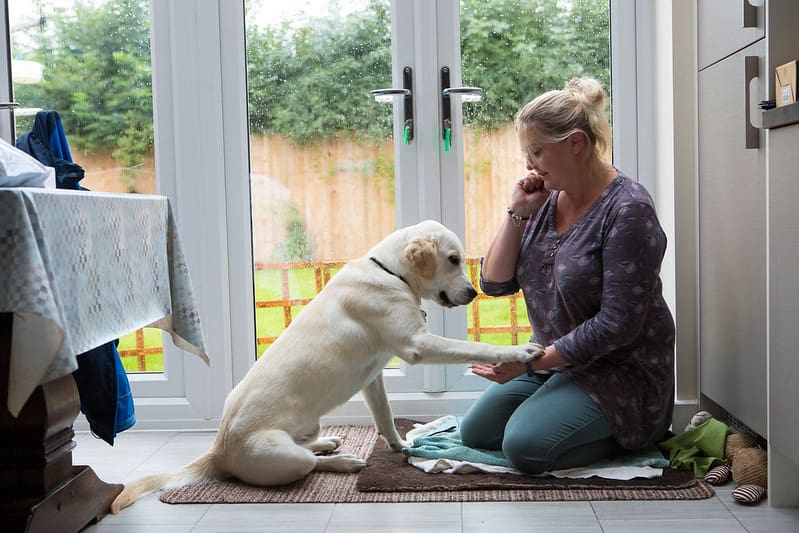Guide to living with your dog for the first time
Welcome to the world of having your dog living with you! Dogs have been ‘our best friend’ for millennia and, if you start your relationship off properly, your dog will lead an enriched, fulfilling life, and become a fantastic companion, and a much-loved member of your own family.

Choosing the most compatible companion for you and your family
Now you have made the decision to share your life with a dog, you will need to think about which type of dog you feel would best enjoy your lifestyle. This is really important because you and your dog will have to integrate into each other’s lives, and whilst you will have to make some compromises, some things, like your accommodation, just cannot easily change.
A high-energy breed such as a Springer Spaniel is less likely to enjoy living in a high-rise flat, as they require ample exercise and access to space. Equally, some dogs need a peaceful home environment, and will struggle living with boisterous children. It is important to consider the uniqueness and variations within breeds and individuals, and not just your own preferences.
Integrating into each other’s lives
Bringing a dog of any age into your home will require a period of adjustment – for you, your family, and the dog. Your dog’s personal level of confidence will affect their adjustment to these changes therefore they may be anxious or overwhelmed when you bring them home. This initial period is key to getting off to a good start, therefore it is essential to be calm, patient and consistent. Remember that whilst some dogs may adjust very quickly, others may take a few months or more to really relax and settle in.
In general terms, a new puppy has less previous experience and fewer expectations to deal with therefore may adjust quickly. A rescue dog will have come from a previous situation which may have left her/him fearful, anxious, depressed, or simply used to a different set of rules and lifestyle. Giving your new dog as long as they need to adjust in a relaxed, quiet environment will give you all the best chance of creating a healthy relationship for years to come.
Getting off to a good start
Here are some tips to follow to give you and your dog the best chance of a good start:
- You will need to devote time to supporting your dog to develop vital life skills, so plan this well in advance. In addition, factor in plenty of quality time for you to exercise, play, and spend time with your dog.
- There are several excellent books available on training a puppy. If you can, review the contents of the book before purchasing to make sure that the training methods do not involve being ‘dominant’ or promote inducing fear or any discomfort unto the dog. These methods are still taught by unregulated ‘professionals’ and will not allow you to build a healthy, trusting relationship between you and your dog.
- Have everything prepared before the dog comes home with you. This involves all the practical things that you need as well as the plan you have formulated with which to meet the needs of your dog alongside your existing routine – at work and at home.
- The following is a list of the essentials you will need to buy beforehand (although the list is not exhaustive):
- Collar or harness
- Identity tag (this is still a legal requirement in the UK)
- Lead
- Washable dog bedding
- Bowls for water and food – suitable for the size of your dog
- A good quality dog food that is appropriate for the life-stage of your dog
- Poo bags (remember for dogs and owners to be valued members of the community, it is our responsibility to clean up after our dogs).
- Safe dog toys
- Appropriate chews
- Be patient and plan extra time to spend with your new dog. If you work, it is advisable to take at least a week off to support your new dog as they settle into their new home with you. Ideally, during the second week, you would carefully and slowly extend the time the dog is left alone so that they do not become anxious about being separated from you. If in reality you are thinking about leaving the dog alone for extended periods, you might want to consider whether the timing is right for you to bring a dog into your life. At a minimum, if you have to be apart from your dog for longer than 4 hours, you will need to plan for friends or family to visit, exercise, and spend time with your dog during that time.
- Building a strong relationship with your dog is vital, but developing this bond takes time and patience. Your dog will need to spend lots of time with you if you are to establish a lasting bond, therefore an occasional quick half an hour of your attention will not suffice. Puppies need to learn life skills carefully (socialisation) to safely prepare them for life. Understanding how to best go about this is paramount in raising them. In addition, all dogs, particularly puppies, require frequent toilet breaks and regular interaction. Puppies also require frequent feeding in small amounts throughout the day.
- Introduce new experiences slowly and gradually. Allow your new dog to take time sniffing and exploring their new home. Read more about your puppy’s first few days.
- It is advisable to not have visitors for the first few weeks, but if you do, introduce your friends and other members of the family to him/her one at a time and in a calm environment. Allow your dog to approach the visitors on their own terms so that they are in control over what they are comfortable with. Remember that puppies like to play which involves putting everything in their mouths – including your hands, feet, and clothing – so prepare younger members of the family that this mouthing is not biting or aggressive but is the puppy exploring their new environment and getting to know new people. Be aware that loud, excitable children can be overwhelming for any dog, particularly one who is new to the family. If managed and taught properly, mouthing should not continue into adulthood.
- Make sure that when your dog is left alone, there are plenty of safe toys to provide mental stimulation and to help enrich their environment. You also need to ensure the environment is safe e.g. cables are tucked away, and dangerous objects are not near the dog.
Teaching your dog skills
You may wish to join a training class. Make sure the class is reputable and provides the positive dog-centred approach necessary to build your trusting relationship. Classes can be as useful for an older rescue dog as they are for providing puppies with valuable life skills. Classes should provide a safe and structured environment for assessment, learning and socialisation under the supervision of a trained professional. Dog training classes are not regulated so it is beneficial to go to visit the provider before committing your dog to its care, to explore whether they provide a calm and friendly atmosphere where dogs and their owners can progress together.
Avoid trainers who use harsh methods, such as dominance or punishment. What the trainer may describe as a firm approach can be a long way from an ethical and encouraging training environment, in which dogs can develop a love to learn through play, praise and reward. Take time getting to know the trainer and finding which one suits you and your dog the best. In the UK, you can find a suitable and local trainer through the Association of Pet Dog Trainers (APDT).
Dog welfare and wellbeing
Choose a good veterinary practice. In the UK, all veterinary surgeons are regulated by the Royal College of Veterinary Surgeons (RCVS) which ensures that all practising vets have followed a regulated course of training and have maintained a level of up to date knowledge (see Choosing a good vet).
Legal responsibilities
The principal responsibilities of all dog owners in the UK are covered by a number of laws. Read more about the understanding dog law in the UK.
Summary
There is a lot to think about for the first-time owner, so researching and preparing will ensure you give your dog the best possible start.
Help support our life-changing work...
Imagine if everyday tasks were so challenging or physically demanding they affected your quality of life. For many people living with a disability of families with a child with autism, that is their reality. Now imagine if a specially trained four-legged friend could restore your, or your family’s, independence.
The demand for our services is high and we can’t help as many people as we would like to without more funding. Please help us continue to bring people and dogs together to help make everyday life possible in so many extraordinary ways.
Every contribution, whatever size, is important and helps us make a difference.

